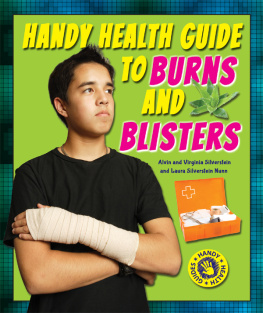WHY DOES MY THROAT HURT?
We all face health problems once in a while. Maybe you have come down with the flu or you have a very sore throat. Perhaps you have asthma or a cavity. Some people need glasses to see better or are allergic to bee stings. These handy guides teach you about your health and how all the parts of your body work together to keep you healthy most of the time.
About the Author
Dr. Alvin Silverstein is a retired professor of biology at the College of Staten Island, City University of New York. Virginia Silverstein translates scientific Russian and is a professional author. Together they have written more than 200 books for young people. Laura Silverstein Nunn has coauthored more than 100 books with her parents.

Image Credit: iStockphoto.com/Christine Glade
A sore throat can make you feel miserable.
You wake up one morning and your throat feels a little scratchy. At breakfast, you have trouble swallowing your food. Oh no, you have a sore throat! You may be coming down with a cold.
A sore throat is often one of the first symptoms of a cold. In fact, colds are the most common cause of sore throats. But many other things can make your throat hurt. Your throat may get sore if you yell too much at a football game. Allergies can also make throats sore.
Most sore throats are not serious. They will go away in a few days to a week. But sometimes, sore throats turn out to be a warning that something harmful is happening inside your body. So how do you know when your sore throat is serious? Read on to find out.

Kids and teens are usually quite healthy and do not have many health problems. But sore throats are one of the most common childhood health complaints. Say Ah!

Image Credit: Juanma Garca Escobar/Photos.com
Has a doctor ever told you to Stick out your tongue and say Ah? The doctor wasnt really interested in seeing your tongue. He or she was trying to get a better look at your throat. Your throat can tell a doctor quite a bit about whats going on inside your body.
Shine a flashlight into your mouth and look at your throat in a mirror. Do you see the flap of tissue hanging down in the back? It looks like a punching bag. That is your uvula.
Behind the uvula is the entrance to your throat, or pharynx. Your pharynx is a tube that carries air to your lungs, food and drink to your stomach, and sounds from your vocal cords to your mouth.

Image Credit: iStockphoto.com/Severin Schweiger
The doctor needs to check your throat to see if it is red and swollen.
As you look through the opening to your pharynx, you can see two large rounded blobs of tissue, one at each side. These are your tonsils. Healthy tonsils are pink, just like the rest of the throat. Although your tonsils are fairly large, they leave plenty of room for air and food to pass down the tube. When you get a cold or other illness, your tonsils may swell up. Sometimes they swell so much that they nearly close off your pharynx.

Image Credit: Shutterstock.com
Open your mouth and look in a mirror. Can you see your tonsils, uvula, and tongue?

Image Credit: PHANIE/Science Source
With the help of computer technology, a doctor can examine a patients vocal cords right in the office.
You cant see it in the mirror, but your pharynx branches into two tubes leading down into the body: the air pipe, or trachea, and the food pipe, or esophagus. When you swallow, a leaf-shaped trap door called the epiglottis closes the opening to the trachea. It prevents liquid and food particles from going down your air pipe. Sometimes, usually when you eat too fast, the epiglottis does not close and something goes down the wrong pipe. (When this happens, you probably have a sudden coughing fit.)

Image Credit: BSIP/ Science Source
Did you realize that your throat has so many parts? The mouth leads to the pharynx, which continues down to either the esophogus or the trachea.

Image Credit: Thinkstock Images/Photos.com
Take a look at the little punching bagthat is the uvulaat the back of this persons mouth.
Look at your neck in the mirror while you swallow. Do you see a lump bulge out and move up and down? That is your voice box, or larynx. Your larynx is part of your trachea. There are two folds of tissue stretched out across your larynx. These are your vocal cords.
When your vocal cords are relaxed, there is a wide space between them, and air can flow through freely. When you talk or sing, your vocal cords move closer together. As air passes between them, they vibrate and make a sound. The thicker your vocal cords, the lower the sound they make. Women and children have shorter and thinner vocal cords than men. Thats why their voices are higher than mens.

Have you ever tried to talk, but no sound came out of your throat? Thats what happens when you have laryngitis. When your larynx gets irritated and your vocal cords swell up, air has trouble moving between your vocal cords. You get laryngitis.
When just a little air can move between your vocal cords, you make sounds that are low, rough, and husky. You have a hoarse voice. Hoarseness is the most common symptom of laryngitis. Laryngitis may be the result of a cold, or may occur if you yell or cough a lot. Fortunately, laryngitis usually lasts only a few days.

Image Credit: iStockphoto/Milorad Zaric
A sore throat may be a warning that you are doing something to hurt yourself. If your food or drink is too hot, it may burn the cells that line your mouth and throat. Burns can be really painful. Luckily, this kind of burn heals quickly. The damaged cells are soon replaced by healthy new ones. After a day or so, your throat wont hurt any more.
How can yelling give you a sore throat? Touch the inside of your mouth with your fingertip. Does it feel wet? The moisture inside your mouth and throat helps keep the cells that line them soft and flexible.
























